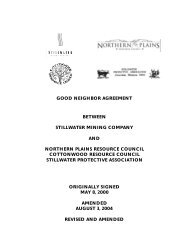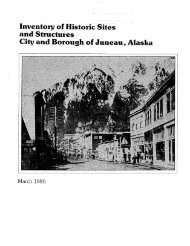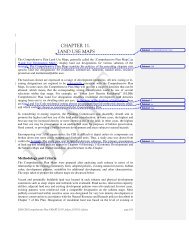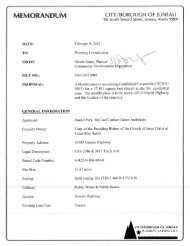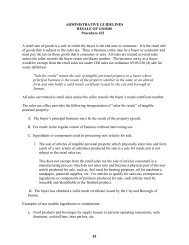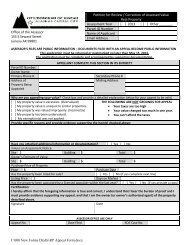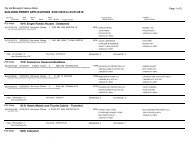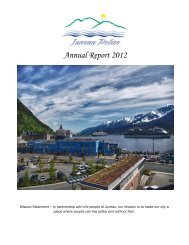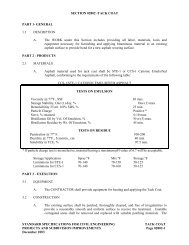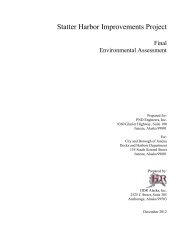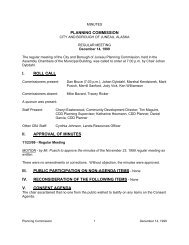Historic Building Survey - City and Borough of Juneau
Historic Building Survey - City and Borough of Juneau
Historic Building Survey - City and Borough of Juneau
Create successful ePaper yourself
Turn your PDF publications into a flip-book with our unique Google optimized e-Paper software.
Development in the fledgling town continued with the construction <strong>of</strong> the Log Cabin Church in<br />
1881, the Northwest Trading Company which was thefirst retail store in Harrisburgh, <strong>and</strong> the<br />
military post Rockwell. George Pilz shipped a pre-framed building from Sitka which became the<br />
first structure in town. In March 1881, Master Gustave Carl Hanus, a Navy <strong>of</strong>ficer from Sitka,<br />
ran lines to formally survey the new town which extended from the waterfront to a prominent<br />
ridge less than a mile away. The ridge area was later called Chicken Ridge. By the end <strong>of</strong><br />
1881, the town had a code <strong>of</strong> local laws, a Board <strong>of</strong> Public Safety to enforce them, <strong>and</strong> a post<br />
<strong>of</strong>fice.<br />
Construction proceeded at a steady pace <strong>and</strong> soon the town began to take shape. The downtown<br />
business district developed almost immediately. Court House Hill, later known as Telephone<br />
Hill, <strong>and</strong> nearby sections were quickly settled <strong>and</strong> as the population grew additional l<strong>and</strong> was<br />
staked <strong>and</strong> cleared. Scattered houses were constructed on the wooded hillsides northeast <strong>of</strong> the<br />
business district. A Native village was established on the waterfront on the current site <strong>of</strong><br />
Willoughby Avenue. Cabins for miners began. to appear on Starr Hill, a working class<br />
residential area <strong>and</strong> by 1893,. the area <strong>of</strong> Chicken Ridge was being settled. In the nine years<br />
following the discovery <strong>of</strong> gold, <strong>Juneau</strong>'s population grew 800 percent from 150 to more than<br />
1,200.<br />
Gold mining was the driving force behind this growth. At first the l<strong>and</strong> was placer mined; then<br />
prospectors attempted towork the larger, higher grade quartz veins they encountered by drilling<br />
<strong>and</strong> blasting to break the gold-bearing quartz from the surrounding waste rock. Eventually, the<br />
prospectors began to consolidate adjoining properties <strong>and</strong> attack the deposit <strong>of</strong> quartz veins on<br />
a larger .scale. By the 1890's, several <strong>of</strong> the small mining companies consolidated on a large<br />
scale <strong>and</strong> out ·<strong>of</strong> this came the Treadwell, Alaska Gastineau, <strong>and</strong> the Alaska <strong>Juneau</strong> mining<br />
companies.<br />
As mining grew <strong>and</strong> large companies exp<strong>and</strong>ed the workings, it became apparent that <strong>Juneau</strong><br />
would not be just another "boom <strong>and</strong> bust" gold camp. Rather, it enjoyed a growing prosperity<br />
built in the mines, with their great mechanized mills, <strong>and</strong> large payroll. The three large mines,<br />
the Alaska Gastineau, the Alaska <strong>Juneau</strong>, <strong>and</strong> the Treadwell drove the economy..The latter two<br />
became the largest gold producers <strong>of</strong> low grade ore in the world, recovering more than $130<br />
million from the mountain rock stamped to dust in the huge mills.<br />
The Treadwell closed in 1917 when three <strong>of</strong> its four operating mines collapsed in a saltwater<br />
cave-in <strong>and</strong>the Alaska Gastineau closed in 1921. The Alaska <strong>Juneau</strong> closed in 1944 due to the<br />
fixed price <strong>of</strong> gold, high ·operating costs, <strong>and</strong> a war-related labor shortage.<br />
For more than 60 years gold mining dominated the identity <strong>of</strong> <strong>Juneau</strong> <strong>and</strong> influenced its growth<br />
but the growth <strong>of</strong> government kept <strong>Juneau</strong>'s economy thriving after the decline <strong>of</strong> the gold<br />
mines. The business <strong>of</strong> government had come about in 1900 when the town had been<br />
.incorporated <strong>and</strong> <strong>Juneau</strong> was designated the temporary seat <strong>of</strong> government <strong>of</strong> the territory. At<br />
this time, <strong>Juneau</strong> had the appearance <strong>of</strong> a thriving city <strong>and</strong> wooden buildings lined the streets.<br />
Residential areas had developed to house both miners <strong>and</strong> a growing number <strong>of</strong> white collar<br />
workers which comprised part <strong>of</strong> the nearly 2,000 people in the town.'<br />
14



